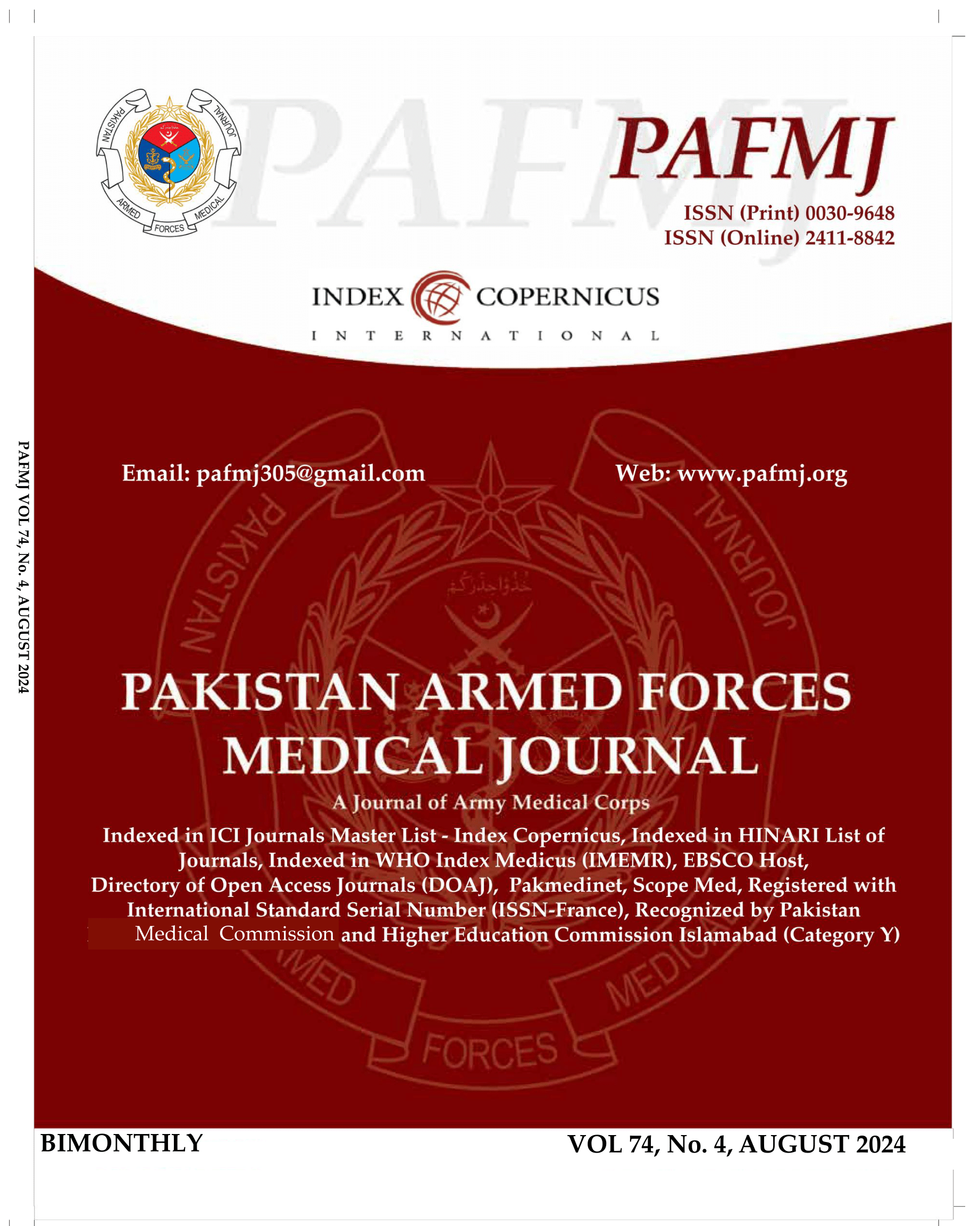Placental Weight To Birth Weight Ratio and Its Outcome Among Neonates
DOI:
https://doi.org/10.51253/pafmj.v74i4.9751Keywords:
APGAR score, Birth weight, Perinatology, PlacentaAbstract
Objective: To calculate Placental Weight to Birth Weight Ratio and its effect among neonates delivered at tertiary care center.
Study Design: Cross-sectional study.
Place and Duration of Study: Obstetrics and Gynecology Department of a tertiary care center, Karachi Pakistan, from Dec 2019 to Feb 2020.
Methodology: Booked cases with singleton pregnancies and gestational ages more than 37 weeks at birth were considered. On a manual scale, the placenta was weighed to the nearest gram. Immediately following delivery, the birth weight of babies was recorded to the nearest gram on the same manual weighing equipment. At 01 minute and 05 minutes, the APGAR scores were noted as well.
Results: The mean age of our respondents was 29.05±5.27 years old. Placental Weight to Birth Weight Ratio ratios were substantially greater in newborns with low APGAR scores than those with high APGAR scores at 1 minute (p=0.001), and the median Placental Weight / Birth Weight was also significantly higher in those infants at 5 minutes (p=0.001).
Conclusion: Poor perinatal outcomes, such as low APGAR scores at 1 and 5 minutes after birth, are associated with high Placental Weight/Birth Weight ratio.
Downloads
References
Elmas B, Simsek D, Dincgez B, Ozceltik G, Urun C, Akin HY. Could Birth Weight to Placental Weight Ratio Predict Postpartum Haemorrhage and Neonatal Intensive Care Unit Admission? J Coll Physicians Surg Pak 2022; 32(12): 1557-1562. https://doi.org/10.29271/jcpsp.2022.12.1557
Ahn KH, Lee JH, Cho GJ, Hong SC, Oh MJ, Kim HJ. Placental thickness-to-estimated foetal weight ratios and small-for-gestational-age infants at delivery. J Obstet Gynaecol 2017; 37(7): 883-887. https://doi.org/10.1080/01443615.2017.1312306
Odibo AO, Goetzinger KR, Huster KM, Christiansen JK, Odibo L, Tuuli MG. Placental volume and vascular flow assessed by 3D
power Doppler and adverse pregnancy outcomes. Placenta 2011; 32(3): 230-234. https://doi.org/10.1016/j.placenta.2011.01.010
R GS, Gebretsadik W, Degefa N, Getahun D, Kassie N. Determinants of Meconium-Stained Amniotic Fluid at Hadiya Zone Hospitals, Southern Ethiopia; Unmatched Case-Control Study. Int J Womens Health 2022; 14: 1351-1360.
https://doi.org/10.2147/ijwh.s376963
Levy M, Kovo M, Schreiber L, Kleiner I, Grinstein E, Koren L, et al. Pregnancy outcomes in correlation with placental histopathology in subsequent pregnancies complicated by fetal growth restriction. Placenta 2019; 80: 36-41.
https://doi.org/10.1016/j.placenta.2019.04.001
Little RE, Zadorozhnaja TD, Hulchiy OP, Mendel NA, Shkyryak-Nyzhnyk ZA, Chyslovska N, et al. Placental weight and its ratio to birthweight in a Ukrainian city. Early Hum Dev 2003; 71(2): 117-127.
https://doi.org/10.1016/S0378-3782(02)00118-4
Panti AA, Ekele BA, Nwobodo EI, Yakubu A. The relationship between the weight of the placenta and birth weight of the neonate in a Nigerian Hospital. Niger Med J 2012; 53(2): 80-84.
https://doi.org/10.4103/0300-1652.103547
Sharma D, Shastri S, Sharma P. Intrauterine Growth Restriction: Antenatal and Postnatal Aspects. Clin Med Insights Pediatr 2016; 10: 67-83. https://doi.org/10.4137/CMPed.S40070
Matsuda Y, Ogawa M, Nakai A, Hayashi M, Satoh S, Matsubara S. Fetal/Placental weight ratio in term Japanese pregnancy: its difference among gender, parity, and infant growth. Int J Med Sc 2015; 12(4): 301-305.
https://doi.org/10.7150/Fijms.11644
Burton GJ, Fowden AL. The placenta: a multifaceted, transient organ. Philos Trans R Soc Lond B Biol Sci 2015; 370(1663): 20140066. https://doi.org/10.1098/rstb.2014.0066
Muneer N, Shamaun S, Shahid A, Jaleel R, Iqbal M, Munir S. Mean Placental Birth Weight Ratio at Term in Primigravidae. Age 24: 4.044. https://doi.org/10.53350/pjmhs2115113496
Audette MC, Levytska K, Lye SJ, Melamed N, Kingdom JC. Parental ethnicity and placental maternal vascular malperfusion pathology in healthy nulliparous women. Placenta 2018; 66: 40-46. https://doi.org/10.1016/j.placenta.2018.04.014
Sanin LH, López SR, Olivares ET, Terrazas MC, Silva MA, Carrillo ML. Relation between birth weight and placenta weight. Biol Neonate 2001; 80(2): 113-117.
https://doi.org/10.1159/000047129
Min AM, Saito M, Simpson JA, Kennedy SH, Nosten FH, McGready R. Placental histopathology in preterm birth with confirmed maternal infection: A systematic literature review. PLoS One 2021; 16(8): e0255902.
https://doi.org/10.1371/journal.pone.0255902
Eskild A, Haavaldsen C, Vatten LJ. Placental weight and placental weight to birthweight ratio in relation to APGAR score at birth: a population study of 522 360 singleton pregnancies. Acta Obstet Gynecol Scand 2014; 93(12): 1302-1308.
https://doi.org/10.1111/aogs.12509
Luque-Fernandez MA, Ananth CV, Jaddoe VW, Gaillard R, Albert PS, Schomaker M, et al. Is the fetoplacental ratio a differential marker of fetal growth restriction in small for gestational age infants? Eur J Epidemiol 2015; 30(4): 331-341. https://doi.org/10.1007/s10654-015-9993-9
De Paepe ME, Shapiro S, Young LE, Luks FI. Placental weight, birth weight and fetal:placental weight ratio in dichorionic and monochorionic twin gestations in function of gestational age, cord insertion type and placental partition. Placenta 2015; 36(2): 213-220. https://doi.org/10.1016/j.placenta.2014.11.009
Takemoto R, Anami A, Koga H. Relationship between birth weight to placental weight ratio and major congenital anomalies in Japan. PLoS One 2018; 13(10): e0206002.
https://doi.org/10.1371/journal.pone.0206002
Kelly AC, Powell TL, Jansson T. Placental function in maternal obesity. Clin Sci 2020; 134(8): 961-984.
https://doi.org/10.1042/CS20190266
Lao TT, Tam KF. Placental ratio and anemia in third-trimester pregnancy. J Reprod Med 2000; 45(11):923-928.
Godfrey KM, Redman CW, Barker DJ, Osmond C. The effect of maternal anaemia and iron deficiency on the ratio of fetal weight to placental weight. Br J Obstet Gynaecol 1991; 98(9): 886-891. https://doi.org/10.1111/j.1471-0528.1991.tb13510.x
Madkar C, Musale J, Deshpande H, Shitole R. A study of Placental weight and birth weight ratio (PW/BW) and it’s effects on perinatal outcome. Indian J Obstet Gynecol 2015; 2(1): 1-6.
Pardi G, Marconi AM, Cetin I. Placental-fetal interrelationship in IUGR fetuses--a review. Placenta 2002;23 Suppl A: S136-141. https://doi.org/10.1053/plac.2002.0802
Hayward CE, Lean S, Sibley CP, Jones RL, Wareing M, Greenwood SL, et al. Placental Adaptation: What Can We Learn from Birthweight:Placental Weight Ratio? Front Physiol 2016; 7: 28. https://doi.org/10.3389/fphys.2016.00028
Shehata F, Levin I, Shrim A, Ata B, Weisz B, Gamzu R, et al. Placenta/birthweight ratio and perinatal outcome: a retrospective cohort analysis. Int J Obstet Gynaecol 2011; 118(6): 741-747. https://doi.org/10.1111/j.1471-0528.2011.02892.x
Downloads
Published
Issue
Section
License
Copyright (c) 2024 Pashmina Gul, Zara Jamali, Komal, Sadaf Imtiaz, Shizra Shahnawa, Fizza

This work is licensed under a Creative Commons Attribution-NonCommercial 4.0 International License.















